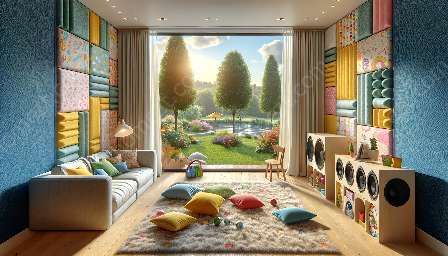Children's rooms should be a peaceful sanctuary where they can rest and play without being disturbed by excessive noise. However, noise levels in children's rooms can be influenced by various factors, including room design, household activities, and external sources. Understanding these factors and implementing appropriate noise control strategies is crucial for creating a quiet and comfortable environment for children and teens.
Factors Influencing Noise Levels
Room Design: The layout and materials used in a child's room can impact its acoustics. Hard surfaces, such as wooden floors and bare walls, can reflect sound and increase reverberation, leading to higher noise levels. On the other hand, soft surfaces, like carpets, curtains, and upholstered furniture, can absorb sound and reduce reverberation, contributing to a quieter atmosphere.
Household Activities: Everyday household activities, such as cooking, cleaning, and watching TV, can contribute to noise levels in children's rooms. Noise generated from these activities can easily travel across the house, reaching children's rooms and disrupting their sleep or concentration.
External Sources: Noise from outside the home, such as traffic, construction, or neighboring properties, can also impact the noise levels in children's rooms. Poorly insulated windows, walls, and doors can allow external noise to infiltrate the room, affecting the overall comfort of the space.
Noise Control Strategies for Children's and Teens' Rooms
Effective noise control strategies can help mitigate the impact of various factors on noise levels in children's rooms, creating a tranquil and conducive environment. Here are some strategies to consider:
- Soundproofing: Install soundproofing materials, such as acoustic panels, to reduce sound transmission and absorb excess noise within the room.
- Soft Furnishings: Incorporate soft furnishings, including rugs, curtains, and upholstered furniture, to dampen sound and minimize reverberation in the room.
- Noise-Reducing Window Treatments: Use double-glazed windows or add soundproof curtains to block external noise from entering the room.
- Noise-Isolating Doors: Install solid-core doors with weatherstripping to prevent noise from traveling through doorways.
- Quiet Appliances: Choose household appliances with low noise levels to minimize the impact of everyday activities on the overall noise environment.
Noise Control in Homes
Addressing noise control in children's rooms is part of creating a harmonious and peaceful living environment for the entire family. In addition to specific strategies for children's and teens' rooms, overall noise control in homes can be achieved through the following measures:
- Strategic Layout: Design living spaces with consideration for noise, such as placing noisy areas, like the kitchen or media room, away from children's bedrooms.
- Insulation: Ensure proper insulation in walls, floors, and ceilings to minimize the transmission of both internal and external noise.
- Noise-Muffling Decor: Introduce sound-absorbing materials and decor, such as wall hangings and bookshelves filled with books, to reduce overall noise levels in shared spaces.
- Establish Quiet Zones: Designate specific areas in the home, such as a reading nook or study corner, as quiet zones where minimal noise disturbance is encouraged.
Conclusion
Creating a peaceful and tranquil environment in children's rooms requires a holistic approach that considers various factors influencing noise levels and implements effective noise control strategies. By addressing room design, household activities, external sources, and overall noise control in homes, families can create a serene atmosphere where children and teens can thrive and rest without being overwhelmed by excessive noise.


